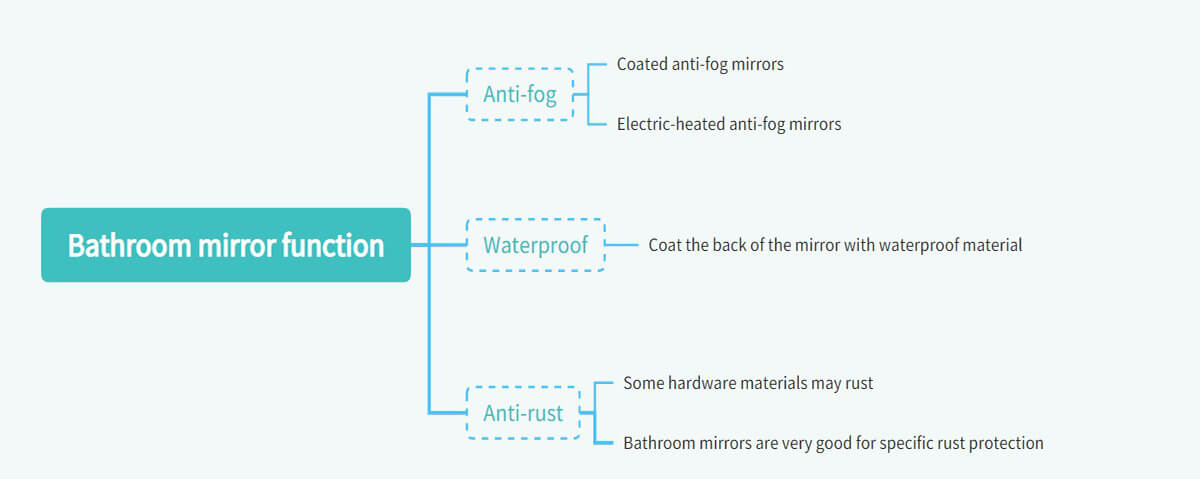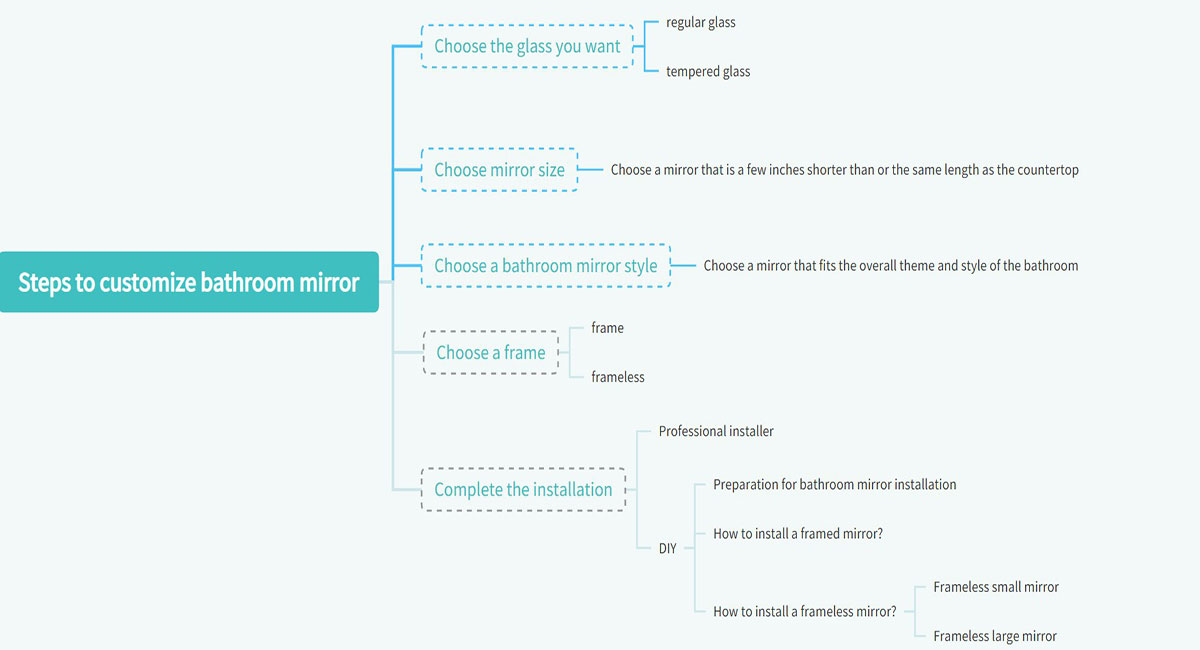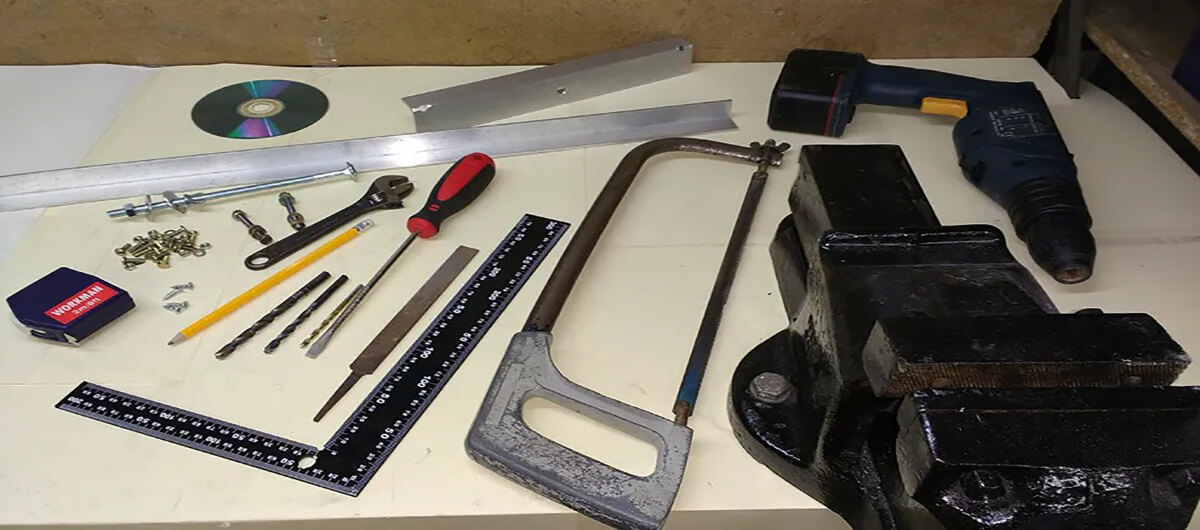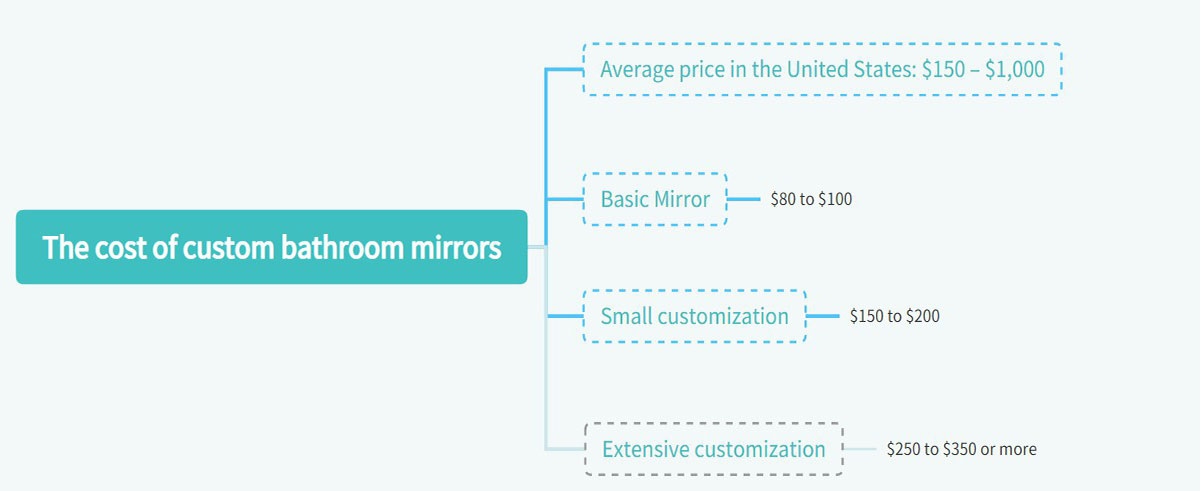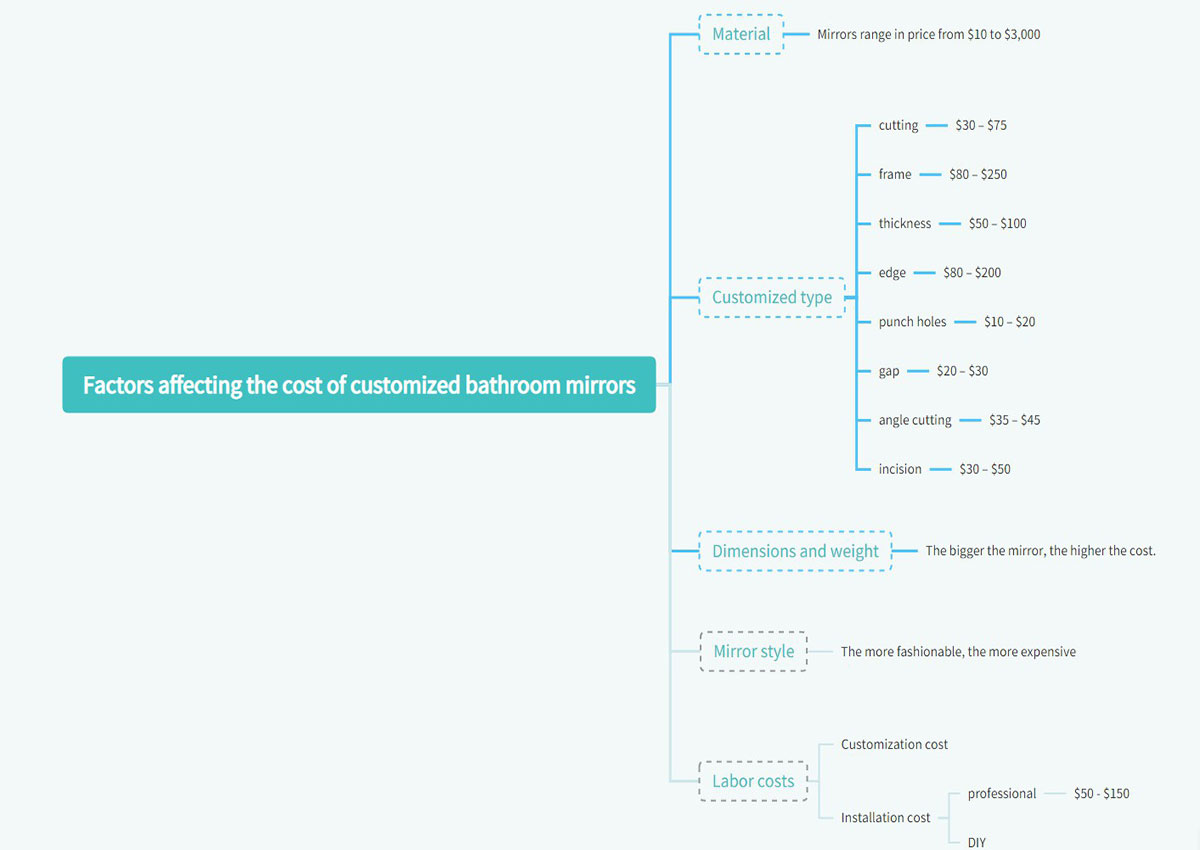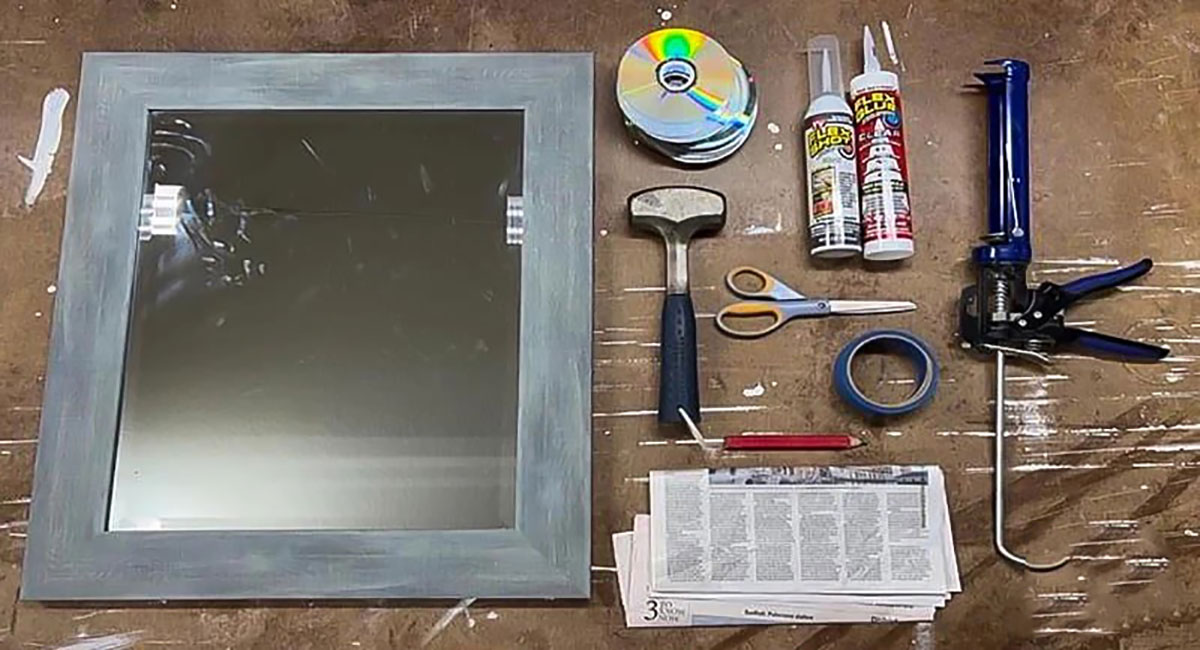Bathroom mirrors are mirrors installed in bathrooms that serve both decorative and functional purposes. Under federal safety laws, bathroom mirrors must be made of tempered glass. This is a special type of glass designed for safety reasons. Unlike regular glass, tempered glass is treated with special chemicals and then molded into the desired shape in a temperature-controlled environment.
Therefore, bathroom mirrors can be customized. You can communicate with the bathroom mirror manufacturer and make a shape that you are satisfied with. So for a novice in customization, how to customize a good bathroom mirror? Don’t worry, in today’s guide, we’ll show you how to customize a bathroom mirror, the factors that affect the cost of a custom bathroom mirror, and answers to frequently asked questions. Read on to learn more.
1. Bathroom mirror function
Have you ever noticed that when you take a shower in the bathroom, the water vapor produced always fogs up the mirror, rendering it useless? Therefore, with the improvement of bathroom mirror manufacturing technology, high-quality bathroom mirrors generally have anti-fog, waterproof, rust-proof, and other functions, and have strong light refraction ability.
1) Anti-fog
According to the anti-fog principle, bathroom mirrors can be divided into coated anti-fog mirrors and electric-heated anti-fog mirrors. Coated anti-fog mirrors prevent a fog layer from forming through the micropores in the coating and are safer, but more expensive. The anti-fog microscope is electrically heated by an electric heating wire or heating film to eliminate fog. Electric anti-fog is relatively primitive, requiring power for its own weight and space on the back of the mirror, but it is cheaper.
When you understand the function of a mirror, you can clearly understand that the anti-fog function of a mirror specially used in the bathroom is very good.
2) Waterproof
Bathroom interiors do have a lot of moisture, so when it comes to paying attention to the many areas involved in using a bathroom mirror, it’s really important to coat the back of the mirror with waterproof material. In the specific use process, it can avoid the problems of mildew, cracking, and even the entire mirror falling off during long-term moisture exposure. This will inevitably bring great safety risks and must be treated with caution.
3) Anti-rust
After being exposed to moisture for a long time, the bathroom mirror itself and some hardware materials may rust. However, when you understand the role of bathroom mirrors, you know that bathroom mirrors are also very good in terms of specific anti-corrosion.
All in all, a high-quality bathroom mirror should be a combination of an anti-fog mirror and a waterproof mirror. It will not leak even if immersed in water. We recommend that you test the mirror to see if it is waterproof before purchasing.
(Another related post: How to Care Bathroom Vanity?)
2. Steps to customize bathroom mirror
Here are the steps for customizing your bathroom mirror.
1) Choose the glass you want
Glass is the raw material for making mirrors. Therefore, when customizing a bathroom mirror, you must first choose its raw materials. Here, you have two options: regular glass and tempered glass. However, the glass most commonly used in bathrooms today is tempered glass. This type of glass undergoes a chemical strengthening process. This prevents it from splitting into thousands of small pieces if it breaks. And offers SafeBreak, a full-coverage backing that keeps the glass safe if it breaks.
Additionally, tempered glass can withstand temperature changes, making it ideal for bathroom environments that deal with changes in heat and humidity from nearby bathtubs and showers. Using tempered glass helps keep you and your family safe.
2) Choose mirror size
Now that you have found the raw materials, the next step is to choose the size of the mirror. So how do you determine the size of the mirror you want? To do this, simply measure the area where you plan to install the mirror. Make sure to measure the space around the mirror where you want it to hang. It is usually located on the bathroom counter or above the sink. For a pleasing look and design, you’ll want to choose a mirror that’s a few inches shorter than or the same length as your countertop. Of course, you can choose any size mirror. However interior designers advise against choosing a mirror that is wider than the edge of the counter. As for height, measure a few inches above your head so you have enough room to view your reflection.
3) Choose a bathroom mirror style
The next step is to choose the style of the bathroom mirror. There are many styles of bathroom mirrors to choose from. For example, wall-mounted mirrors, decorative mirrors, uniquely shaped mirrors adjustable mirrors, etc. Overall, you should choose a mirror that fits the overall theme and style of your bathroom. For example, if you use metal fixtures in your bathroom, you can choose a brass wall mirror to match the decor theme.
4) Choose a frame
Of course, it is entirely up to you whether you want to install a bathroom mirror frame or not. If you don’t want to install a frame. Then you won’t have to rack your brain to pick a frame that matches your bathroom mirror. But on the contrary, if you want to customize a unique frame for your bathroom mirror. This is also possible, but it requires your imagination. Because there are over 200 possible combinations of mirrors and frames. Be sure to communicate clearly with the designer when designing, which can reduce a lot of unnecessary trouble. Be sure to work with a reliable manufacturer so you can change or replace the frame immediately if it doesn’t fit.
(Another related post: A Complete Buying Guide for Bathroom Mirror)
5) Complete the installation
This is the final step in customizing your bathroom mirror. Mirrors can be hung flush with the wall or float so the mirror is closer to you. You can choose to hire a professional installer to install the mirror or DIY it yourself. If you want to DIY, here are some steps for installing a bathroom mirror for your reference.
There are actually two main types of bathroom mirrors: framed mirrors and frameless mirrors. Most framed bathroom mirrors are hung from brackets or wire, much like a picture frame. Frameless bathroom mirrors can be attached to the top of the vanity using special clips or with adhesive.
#1. Preparation for bathroom mirror installation
- Have all the tools you may need ready and set aside.
- If you use mounting brackets, be sure to place them on a level surface so that they support the weight of the mirror evenly.
- If it’s a larger bathroom mirror, find an assistant to help you.
#2. How to install a framed mirror?
- First, check to see if the frame has hangers. If the frame doesn’t already have brackets that are centered at the top of the frame, connect a wire between the two side brackets so that the curve of the wire is slightly lower than the top of the frame when tensioned.
- Wrap the wire around a few times and use pliers to cut off the excess.
- Mark the area on the wall where you want the installation and install an appropriately sized hook.
- Hang the mirror wire on the hook and adjust the mirror so it is level.
#3. How to install a frameless mirror?
Frameless mirrors can be installed in two ways, depending on the size of the frameless mirror.
(1) Frameless small mirror
- The first step is to determine where the mirror will be installed and mark it.
- Determine the number of clips needed based on the size of your mirror.
Note: Before installing, always consider the composition of the wall or door where the mirror will be installed.
(2) Frameless large mirror
- Mark the mirror’s location and then position the mirror close to its final location.
- Apply mirror adhesive to the back of the mirror and/or the wall, following the manufacturer’s instructions.
- Move the mirror to the adhesive and support it so the mirror is firmly attached to the wall.
Things to note when installing mirrors:
- Heavier mirrors require special care.
- Know the wall type before installation. The type of wall determines how the mirror is installed. Is it drywall, plaster, or masonry? If you’re not sure, try driving small thumbtacks into the wall. If it’s drywall, push pins are easy to insert.
- Know the weight of your mirror. Knowing the weight of a mirror can help you determine whether the hanging hardware can handle the weight of the mirror. Your suspension hardware may state a weight limit.
(Another related post: How to Install a Bathtub?)
3. The cost of custom bathroom mirrors
The price of a custom mirror varies based on several factors, ranging from a few hundred dollars to a few thousand dollars. According to research, the price range for a custom-made mirror in the United States is $150 – $1,000.
- Basic Mirror: A basic 36-inch square edge seam mirror usually costs about $80 to $100. However, seam edges are essentially unfinished edges, so the mirror will need to be beveled or framed to remain safe in the home. Adding bevels, frames or other customizations can add cost.
- Small customization: A 36-inch square mirror with some minor customizations, such as a frame or bevels, typically sells for about $150 to $200.
- Extensive customization: Adding a variety of custom features to a 36-inch square mirror, such as frames, custom cuts, and added thickness, can cost around $250 to $350 or more.
(Another related post: Bathroom Mirrors Vs. Regular Mirrors: What’s The Difference?)
4. Factors affecting the cost of customized bathroom mirrors
Many factors affect the cost of a custom bathroom mirror, let’s take a look at some of the main ones.
1) Material
The cost of materials is probably the largest cost you will spend on a custom bathroom mirror. Because this is the basis for custom bathroom mirrors, it is essential. Mirrors range in price from $10 to $3,000, but you can find a basic 36-inch square mirror with seamed edges for around $80 to $100.
2) Customized type
The custom type is a makeover on your base mirror. You will be charged for any customization required, such as custom cuts, frames, or bevels. The more customization, the higher your costs. Below are basic price ranges for some customization factors.
| Customization factors | Cost range |
| cutting | $30 – $75 |
|
picture frame |
$80 – $250 |
| thickness | $50 – $100 |
| edge | $80 – $200 |
| punch holes | $10 – $20 |
| gap | $20 – $30 |
| Angle cutting | $35 – $45 |
| incision | $30 – $50 |
3) Dimensions and weight
Simply put, the bigger the mirror, the higher the cost. This applies to size and weight. Additionally, shipping costs are also something to consider. Larger mirrors will cost more to ship to your home, especially since they require extra care to prevent breakage.
If you want to take the next step and design your own images, keep in mind that custom image pricing can significantly affect the price. Especially if you order non-standard sizes.
4) Mirror style
Most bathroom mirrors are stylish. Unfortunately, fashion mirrors are more expensive than regular mirrors. So the more stylish you want your mirror to be, the more you will have to pay for it.
5) Labor costs
The labor cost is not only the labor cost of a custom bathroom mirror but also the installation fee. The size and complexity of the mirror may mean you need to hire someone to install it. Labor costs to install a mirror typically range from about $50 to $150, depending on the size of the mirror and the complexity of the job. Of course, if you think you can install it yourself, this will save you money.
(Another related post: How to Choose a Mirror for the Whole Home?)
5. FAQ
Here are answers to frequently asked questions about custom bathroom mirrors.
1) Should I buy a custom mirror?
This issue needs to be viewed in light of the actual situation. We recommend that you don’t customize your mirrors unless necessary. Bathroom mirrors come in many sizes and types, and it’s generally easy to find the bathroom mirror you want. In this case, there is no need for custom mirrors as they cost more than non-custom mirrors. However, if your bathroom space is very specific and you cannot find a mirror of the right size on the market. This is when a custom mirror is ideal.
2) What are the disadvantages of custom bathroom mirrors?
The biggest disadvantage of custom mirrors is their high cost. And the cost will change with the type of customization you have. The more and more complex the factors you customize, the cost will increase accordingly. In addition, custom mirrors can be customized if you want to make changes at a later stage. Then you need to hire professional personnel to operate it. The cost here will also be higher than a regular mirror.
3) Can I customize the mirror myself?
You can DIY your mirror, which will save you money. For example, a glass cutter costs about $10 to $20, but professionals typically charge around $30 to $75 for mirror cutting. However, if you want a more intricate custom bathroom mirror. To prevent the mirror from being damaged, we recommend that you find a professional to operate it.
(Another related post: How to Choose the Perfect Backlit Bathroom Mirror?)
6. Conclusion
The above is the relevant knowledge about custom bathroom mirrors compiled in this guide. After understanding the above knowledge, I believe you have a better understanding of customized bathroom mirrors. If you would like to customize a bathroom mirror now, please contact Nicemoco.






